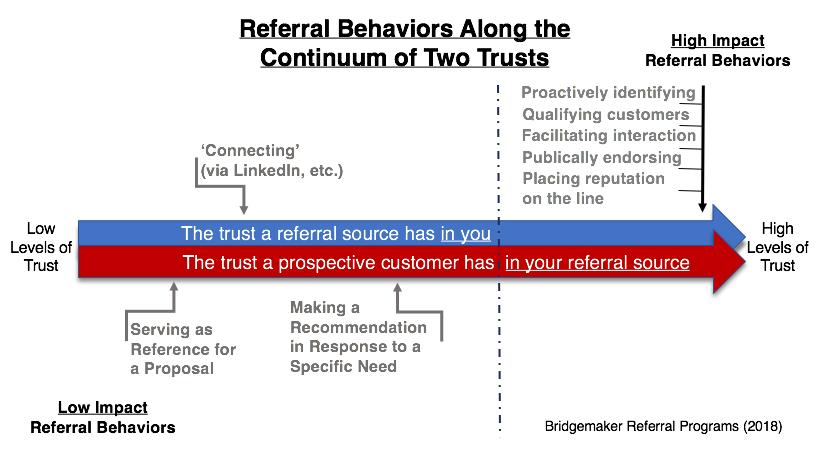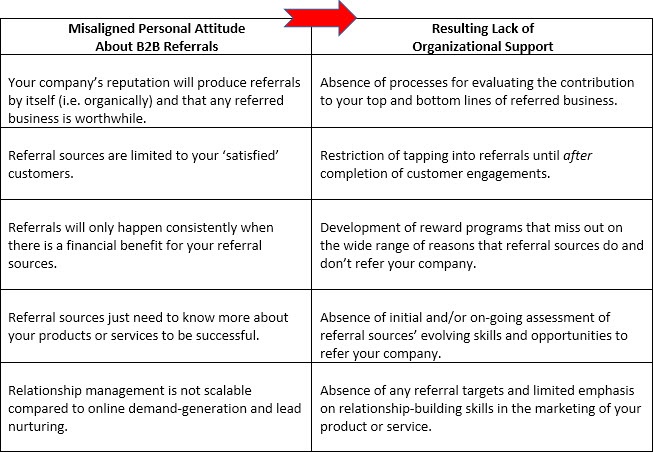Implementing A High Impact Referral Strategy: How To Turn Referrals Into Revenue
By Andrew Brown, Bridgemaker Referral Programs

Ask any successful software executive and they will undoubtedly claim with great confidence that leveraging referrals is a critical component of their sales strategy. That certainly makes sense given the dramatic results from a recent study that quantified referral program outcomes. The study of over 600 B2B companies across North America found the following revenue-generating benefits for those companies with formalized referral programs, when compared with organizations without such programs:
- 71 percent of prospective sales deals are more likely to close;
- 69 percent of prospective sales deals close faster; and
- 59 percent of customers coming via referrals bring higher lifetime value*.
You’re always looking for ways to increase the number of high-quality prospects and accelerate them quickly through the sales funnel. So, upon seeing these results, you could conclude that it’s time to re-direct marketing and sales resources to programs that optimize referrals.
However, before you do this, there is a harsh and overlooked reality upon which all successful referral programs are based: not all referrals are created equal. With that said, you must address three issues to effectively leverage B2B referrals that deliver top (and bottom) line results:
- Focus on the kinds of referrals that are most effective at generating profitable business;
- Call out the obstacles that prevent you from tapping into the most effective referrals; and
- Take specific actions to harness the most effective referrals.
B2B Referrals That Mean Business: Focusing On High Impact Referrals
As a successful software executive, you have seen a host of referral behaviors over the years. Those behaviors have produced a variety of outcomes where you’ve expressed everything from ‘That was a waste of time and expense’ to ‘Wow, we just got a big win’. What’s frustrating is that such outcomes can appear to be unpredictable or random. The good news is that you can identify, measure, and manage the specific kinds of referral behaviors that lead to consistently acquiring new and profitable business – those behaviours that result in High Impact Referrals (HIR). By managing these referral behaviors, you can better predict likely outcomes and refine your sales plans accordingly.
To begin, you need to recognize that underpinning all types of referral behaviours is trust, specifically two kinds of trust: 1) The trust a referral has in you, your product and/or your organization; and 2) The trust that the prospective customer has in your referral source. These two kinds of trust evolve independently. But, they combine to shape your referral sources’ referral behaviors – which determines how effective they are at successfully converting a prospect into your new customer. To see how this plays out daily, let’s plot today’s most common referral behaviors along the Continuum of Two Trusts (see Figure 1).

Figure 1: The Continuum of Two Trusts
One common referral behavior includes connecting in person at a business function or on a social media platform such as LinkedIn. This kind of referral behaviour happens typically when both types of trust are low. That’s because for a referral source to initiate an introduction (or make a “connection” in social media), they know you, but they don’t need to have a high level of trust in you. At the same time, a prospective customer knows how easy it is for a referral source to make a connection (or social ‘Like’ or re-tweet). So, the level of trust that accompanies the connector (that is, the trust in your referral source) is low. This type of referral behavior is at best spotty when it comes to consistently increasing the likelihood of gaining a new customer or reducing the time to acquire a new customer. Other referral behaviors that are displayed when one or both kinds of trust is low include acting as reference on a proposal and making a recommendation in response to generic needs like, ‘We’d like to lower our HR admin costs.’
In contrast, when both kinds of trust are high, your referral sources behave in ways that are most effective at converting prospects into your new customers. These High Impact Referrals result when your referral sources demonstrate the following behaviors:
- proactively identifying potential opportunities and bringing them to you
- qualifying opportunities so that you don’t waste time pursuing the wrong opportunities
- facilitating meaningful interactions between you and the right people rather than simply ‘connecting’
- initiating opportunities when the time is right given the prospective customer’s unique conditions and constraints
- initiating opportunities when your company has the capacity to on-board and satisfy the unique needs of a specific prospective customer
- placing their personal and/or professional reputation on the line by providing a hearty endorsement for you (often in a public setting)
Implementing A High Impact Referral Strategy B2B (Part 1): Identifying The Obstacles
Having pinpointed the measurable behaviors that lead to High Impact Referrals, let’s focus on the obstacles preventing software executives from enabling, and realizing the benefits of, these referral behaviors. They fall into two broad ‘buckets’ (see Figure 2). The first set of obstacles are misaligned attitudes about referrals which give rise to the second set of obstacles, a lack of organizational support. The former prevents initiating structured referral programs and the latter hampers their implementation.
Figure 2: Obstacles to Leveraging High Impact Referrals
Implementing A High Impact Referral Strategy B2B (Part 2): Overcoming The Obstacles
While overcoming these obstacles requires a concerted effort, doing so can be part of a growth strategy that catapults companies in highly competitive markets. After all, the number of companies that have adopted structured referral programs has remained at 30 percent over the last half-dozen years* – despite findings like those in a recent study where 74 percent of companies concluded that leveraging referrals is the least expensive method of acquiring new customers**.
Here’s a quick five-point step plan for overcoming the obstacles preventing you from harnessing high impact referral behavior and achieving the benefits of High Impact Referrals.
Step 1: Ask your Sales (or Marketing) Department to identify how much revenue your business received over the last 12 months that can be attributed to referrals.
Step 2: Ask your Sales (or Marketing) Department to review the profitability of the business that originated through the five to ten referral sources that have brought you the greatest number of opportunities in the last 12 months.
Step 3: Along with your Sales (or Marketing) Department leader, speak with the three referral sources that have brought you the most profitable business opportunities to you in the last 12 months so you can gain an understanding of why they consistently bring you profitable business.
Step 4: Assign a relationship-manager responsibility for identifying the reasons why referral sources bring you opportunities that are/are not profitable.
Step 5: Set initial benchmarking referral targets for a sample of your referral sources – just as you would for your direct sales efforts, your proposal response efforts, and your demand-generation campaigns.
By implementing these five steps, you can outline personalized and measurable action plans that address the strengths and weaknesses of each referral source. In doing so, you will be able to continually assess in which organizations and industries your referral sources are recognized as being trustworthy. The result: you will be able to facilitate high impact referral behaviors and achieve the enviable business benefits of high impact referrals.
*Study: What You Should Know About B2B Referrals. Benchmarking B2B Referral Program Adoption and Results. (Heinz Marketing and Influitive).
**Study: The State of Referral Marketing in 2017 (Web Profits).
About The Author
Andrew Brown is Founder and Chief Innovation Officer of Bridgemaker Referral Programs. He is the lead author of the ‘How to Grow Your Business Through Better Relationships’ series – which includes books on getting the most from referral sources, channel partners, and strategic alliances.
